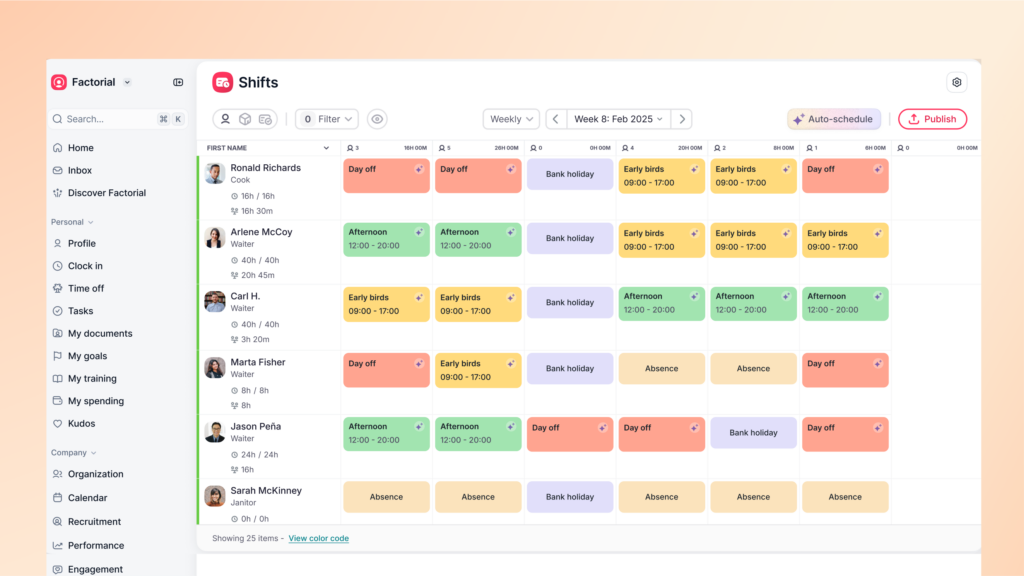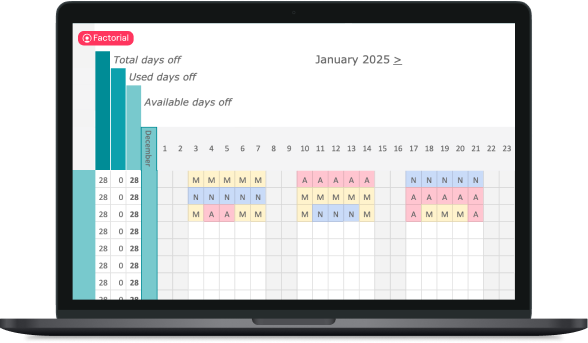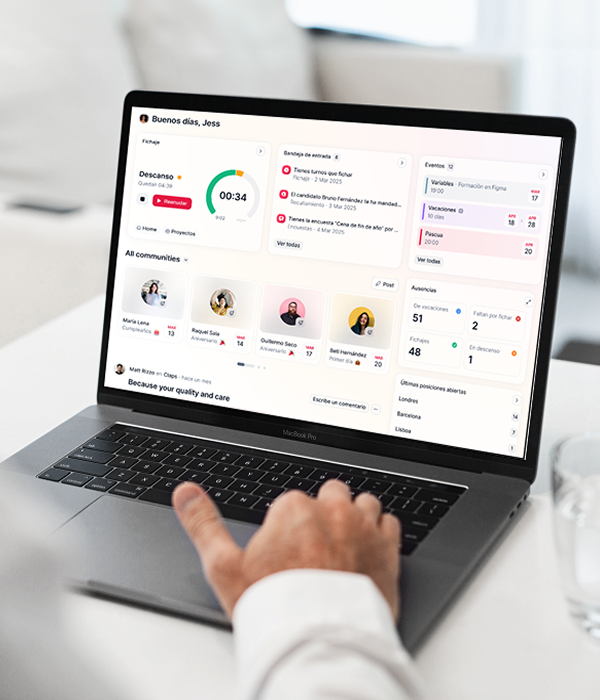Creating work schedules for employees can feel like putting together a giant puzzle. Between balancing staff availability, staying compliant with labor laws, and keeping your team happy, it’s no wonder many managers spend hours each week trying to make everyone’s shifts fit.
And when things go wrong with overlapping shifts, last-minute swaps, or confusion about who’s working when, it affects more than your calendar. It can lead to frustrated employees, poor coverage, and even burnout.
But the good news is that employee scheduling doesn’t have to be a headache. With the right strategy, tools, and a bit of planning, you can create shift schedules that are fair, compliant, and perfectly aligned with your business needs whether you’re running a restaurant, managing a retail store, or coordinating a hybrid office team.
This guide will walk you through everything you need to know about creating work schedules for employees. From understanding different types of shift structures, to tackling common scheduling challenges, to using modern shift management software like Factorial to simplify the entire process, we’ve got you covered.
By the end, you’ll not only know how to make an employee schedule that works, you’ll be able to build one that actually helps your business thrive.

Why Employee Schedules Matter
Creating work schedules for employees is one of the most important parts of running a successful business, yet it’s something many managers struggle with.
A strong employee schedule keeps your business running smoothly. A weak one can lead to confusion, burnout, and high turnover.
Whether you manage a restaurant, retail store, or hybrid office, your schedule affects how happy your employees are, how efficient your team works, and how profitable your business becomes.
Here’s why getting your schedule right really matters.
1. Stay Compliant with Labor Laws
When you create an employee schedule, it’s not just about filling time slots, it’s about following the rules. Most regions now have predictive scheduling laws or fair workweek rules. These laws require managers to give employees advance notice of their shifts and to pay extra if changes are made last-minute.
Keeping up with all the rules can be tricky, but a well-planned schedule helps you:
- Avoid unplanned overtime
- Respect rest periods between shifts
- Follow maximum working hour limits
- Keep accurate records for payroll and audits
Building compliance into your scheduling process keeps your business protected and shows your team that you respect their rights and time.
2. Ensure Fairness and Transparency
Fairness is key when creating work schedules for employees. If one person always gets the best shifts while another gets stuck with nights and weekends, frustration builds quickly.
Transparent scheduling helps employees understand why they’re assigned certain shifts. It also helps managers avoid favoritism whether intentional or not.
With digital tools like Factorial, you can take fairness to the next level. Factorial’s employee self-service portal lets workers:
- Enter their availability
- Request time off
- Swap shifts (with manager approval)
- See updated schedules instantly
When employees can view and manage their schedules easily, it builds trust and teamwork, and saves managers hours of back-and-forth communication.
3. Boost Engagement and Reduce Turnover
Your schedule sends a clear message about how much you value your team. Employees with consistent and fair schedules are happier, less stressed, and more loyal.
On the other hand, constant scheduling issues, last-minute changes, or poor communication can push great employees to leave.
A thoughtful schedule gives people stability and helps them balance work and personal life. This leads to higher engagement, stronger performance, and lower turnover, all of which save your business time and money in the long run.
4. Improve Efficiency and Coverage
When you make an employee schedule that matches your business needs, you’ll always have the right number of people on shift. This balance prevents:
- Understaffing, which causes burnout and poor service
- Overstaffing, which drives up labor costs unnecessarily
Planning ahead helps you align shift coverage with busy hours or seasonal demand. For example, if you manage restaurant schedules, you know weekends and holidays need more staff while weekday mornings may require fewer.
Using an employee shift schedule generator or restaurant shift scheduling software can help you predict coverage needs and create more balanced shifts with less manual effort.
5. Build Accountability and Reliability
A clear schedule helps everyone know exactly when and where they’re supposed to work. This reduces no-shows, confusion, and miscommunication.
When employees have access to their schedules online and receive automatic notifications about any updates, they’re more likely to show up prepared and on time.
For managers, this builds reliability across the team. When everyone knows what to expect, daily operations run smoother.
6. Save Managers Time and Reduce Stress
Creating work schedules manually can take hours each week, especially if you’re managing multiple locations or a 24/7 operation.
Digital tools like Factorial make it easy to create an employee schedule, assign shifts, and send out notifications in just a few clicks.
You can even use employee schedule templates or automate recurring shifts for faster scheduling.
With shift scheduling software, you can:
- Automatically fill open shifts based on availability
- Avoid double-booking and conflicts
- Update schedules instantly
- Notify employees automatically of any changes
That means less admin work for you and fewer mistakes that can cause confusion or overtime costs.
7. Adapt to Modern Work Models
Today’s workplaces are more flexible than ever. Many teams use hybrid work schedules, asynchronous work, or even alternative models like the 9/80 schedule, where employees work nine days instead of ten each pay period.
These setups require flexible scheduling systems. Factorial’s shift management software makes it easy to handle different types of shift schedules from traditional 8-hour shifts to rotating or flexible ones while keeping everything organized in one place.
You can easily adjust your staff schedule as business needs or employee preferences change, without starting from scratch each week.
By using digital shift management tools like Factorial, you can simplify scheduling, reduce errors, and create a more connected, motivated workforce.
👉 Take a tour of Factorial to see how it can simplify your scheduling process.
Understanding the Different Types of Shifts
When you’re creating work schedules for employees, one of the first steps is deciding what kind of shifts make sense for your business. The right shift structure helps you cover your busiest hours, keep labor costs balanced, and meet employee needs.
Not every company operates on a traditional 9-to-5 schedule anymore. From 24/7 coverage to hybrid or flexible options, there are many ways to organize your team’s working hours.
Let’s look at the most common types of employee schedules, along with their pros, cons, and which industries they work best for.
| Shift Type | Pros | Cons | Best For |
| Fixed Schedule | Predictable, easy to manage, stable for staff | Less flexible, hard to adjust to changes | Offices, retail, small businesses |
| Rotating Schedule | Covers 24/7 needs, spreads work evenly | Harder to manage, disrupts routines | Healthcare, hospitality, manufacturing |
| Split Shift | Matches busy hours, saves labor costs | Can tire employees, long days | Restaurants, delivery, call centers |
| On-Call | Great for unpredictable demand | Unreliable hours, hard to budget | Maintenance, healthcare, service work |
| Compressed (9/80) | Improves morale, fewer workdays | Coordination challenges | Office or hybrid teams |
| Seasonal | Matches labor to busy periods | Requires temporary hiring | Retail, tourism, hospitality |
| Flexible / Hybrid | Encourages work-life balance, modern | Harder to track or communicate | Office teams, remote or hybrid setups |
| Shift Differential | Encourages night or weekend coverage | Raises labor costs | 24/7 operations, logistics, hospitals |
How to Choose the Right Type of Schedule
When deciding what type of shift schedule to use, think about three main factors:
Your business hours and workload
- Do you operate around the clock or only during specific hours?
- Do you need more staff at certain times (like during lunch rushes or holidays)?
Your employees’ needs
- Some employees prefer stability, while others value flexibility.
- Allowing employees to share their availability and preferences can reduce scheduling issues and improve satisfaction.
Legal and compliance requirements
- Check your local laws for predictive scheduling or overtime limits.
- A fair and compliant schedule keeps you safe from fines and boosts employee trust.
Step-by-Step Creating Work Schedules for Employees
Creating work schedules for employees can feel like a puzzle, especially when you have a mix of full-time, part-time, and flexible staff. The good news is that if you follow a clear, step-by-step process, it becomes much easier to make an employee schedule that’s fair, compliant with rules for employee types, and efficient.
Here’s a practical guide you can follow to create staff schedules without the stress.
Step 1: Define Business and Staffing Needs
Before assigning shifts, you need to understand what your business actually requires:
- List the hours your business is open and identify peak times.
- Determine how many employees you need for each shift.
- Consider the type of work each role requires, for example, servers vs. kitchen staff or customer support vs. admin.
- Take note of special days like holidays, events, or sales campaigns.
Tip: Use an employee shift schedule generator or restaurant shift scheduling software to map out coverage visually — it makes spotting gaps much easier.
Step 2: Identify Constraints and Compliance Rules
Next, check the rules that affect scheduling:
- Overtime limits: Employees shouldn’t work more than legal hours per week.
- Rest periods: Make sure staff have enough time between shifts.
- Predictive scheduling laws: Some regions require advance notice for shifts.
- Fair distribution of shifts: Rotate desirable and less popular shifts evenly to keep staff happy.
Pro tip: Digital shift scheduling software can automatically flag conflicts with compliance rules and save hours of manual checking.
Step 3: Gather Employee Availability and Preferences
Employees need to be part of the process. Collect:
- Days and hours they can work
- Any restrictions (e.g., school schedules, childcare, other jobs)
- Preferences for certain shifts (day vs. night, weekends, etc.)
Using Factorial’s self-service portal, employees can enter their availability directly. This reduces scheduling errors and allows managers to swap shifts efficiently without chaos.
Step 4: Build Your Shift Structure
Now it’s time to organize your team into actual shifts:
- Decide on shift lengths (e.g., 8-hour, 12-hour, split shifts).
- Assign staff based on availability, experience, and role.
- Use templates or software to make employee schedules faster.
Tip: Color-coding shifts or roles in your schedule can make it easy to see gaps and coverage at a glance.
Step 5: Automate Scheduling and Notifications
Automation saves time and prevents mistakes:
- Many shift scheduling software platforms, like Factorial, can automatically fill open shifts based on availability.
- Employees get instant notifications when shifts are added or changed.
- You can allow swap shifts requests to be approved digitally without back-and-forth emails.
Automation reduces errors, ensures fairness, and keeps your team in the loop, making life easier for both managers and staff.
Step 6: Review, Optimize, and Adapt Regularly
Even the best schedule may need adjustments. Keep improving by:
- Gathering feedback from employees on workloads and preferences.
- Checking whether peak hours are fully covered.
- Updating schedules for seasonal demand, holidays, or staff changes.
- Adjusting for emergencies, no-shows, or last-minute requests.
A flexible schedule that adapts to real-world changes keeps operations smooth and employees satisfied.
How to Make Scheduling Easier for Your Team
Creating work schedules for employees can be time-consuming, but with the right strategies, managers can save time and keep staff happy. This section focuses on solutions that make scheduling smoother without diving into the challenges themselves.
1. Plan Ahead with Availability
Knowing when employees can work makes scheduling much easier.
Tips:
- Use a self-service portal like Factorial so employees can submit availability.
- Collect preferences early to ensure fair shift distribution.
- Keep a record of recurring constraints to avoid last-minute changes.
2. Automate Wherever Possible
Manual scheduling can take hours and lead to errors. Automation helps you streamline the process.
How it helps:
- Employee shift schedule generators can create schedules in minutes.
- Automatic notifications let employees know their shifts instantly.
- Features like swap shifts reduce back-and-forth communication.
3. Manage Multiple Shift Types Clearly
Different shift types such as rotating shifts, split shifts, hybrid work schedules, or shifts with differential pay can get confusing.
Tips:
- Label shifts clearly in your schedule.
- Keep all shift types in one central system.
- Ensure employees only see relevant information to maintain privacy.
4. Regularly Review and Adjust
Schedules should be flexible enough to adapt to changing needs without disrupting operations.
Strategies:
- Ask employees for feedback on their schedules.
- Adjust workloads to keep shifts balanced.
- Track patterns like overtime or peak demand to plan ahead.
5. Use the Right Tools
Digital tools make scheduling much easier and reduce the administrative burden.
Benefits:
- Create and manage schedules quickly with a shift management system.
- Avoid errors when covering shifts or handling multiple teams.
Factorial, for example, allows you to create staff schedules, notify employees automatically, and manage all shift types in one place.
Tools to Help You Create and Manage Employee Schedules
Creating work schedules can be tough, especially when you have many shifts and different employee availabilities. The right scheduling tools make it faster, easier, and more accurate.
1. Why Use Scheduling Tools?
Scheduling tools help managers plan shifts, avoid mistakes, and keep everyone informed. They have many benefits:
- Create schedules quickly (no more long spreadsheets)
- Track availability and time-off requests automatically
- Avoid overlapping shifts or overtime issues
- Send instant updates when schedules change
2. Key Features to Look For
When choosing a scheduling tool, look for:
- Employee portal: Staff can set availability, request time off, and view schedules
- Shift management: Automatically assign or swap shifts
- Reminders: Alerts for new or changed schedules
- Templates & automation: Save time with pre-made schedules
- Permissions: Control who can see or edit schedules
3. Making Schedules with Factorial
Factorial makes scheduling simple:
- Employees add their availability online
- Managers assign or adjust shifts easily
- Automatic notifications send updates
- Works for rotating, hybrid, or split shifts
Factorial saves time, reduces errors, and keeps schedules fair and up-to-date.
4. Benefits for Managers
Using tools like Factorial means:
- Less time spent on manual scheduling
- Fewer conflicts or mistakes
- Happier employees with fair schedules
- Easier compliance with labor laws
5. How It Fits Your Workflow
Scheduling tools help you:
- Plan shifts weeks ahead
- Quickly adjust for changes or emergencies
- Keep records for payroll or reports
- Combine with HR tools like time tracking
Creating employee schedules doesn’t have to be stressful. With digital tools, templates, and good communication, managers can save time, reduce confusion, and keep teams organized.
FAQs About Creating Shift Schedules
1. How do you create a work schedule?
List shifts and roles, collect employee availability, and use a schedule template or software like Factorial to assign shifts and share them.
2. How to make a work schedule for 5 employees?
Match each employee’s availability with required shifts, ensure fair hours, and use software to manage swaps or changes.
3. How to make a work schedule for 8 employees?
Plan for coverage and balance workloads. Use templates or digital tools to handle rotating shifts and send updates automatically.
4. How to make a schedule template?
Create a table with days, shift times, employee names, and roles. Save it to reuse weekly or monthly. Tools like Factorial offer ready-made templates.
5. How to make an effective schedule?
Collect availability early, balance hours fairly, follow labor laws, and use scheduling software to reduce mistakes.
6. What’s the best way to schedule employees?
Plan ahead, communicate clearly, use templates or software, and adjust regularly for fairness and efficiency.



